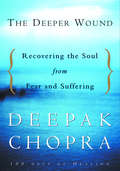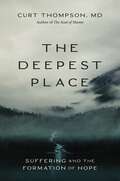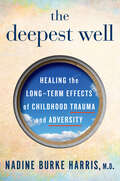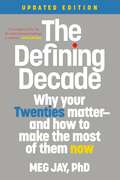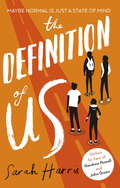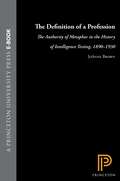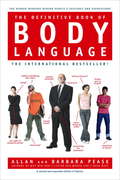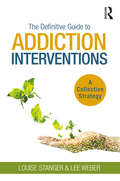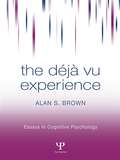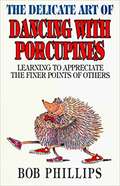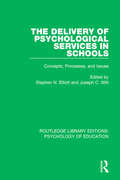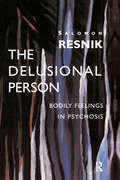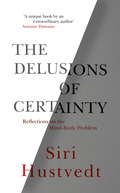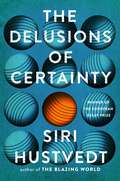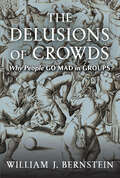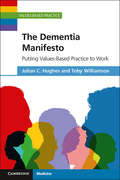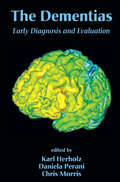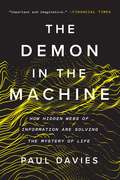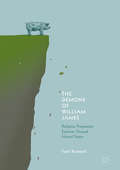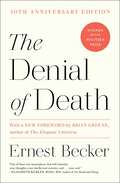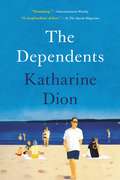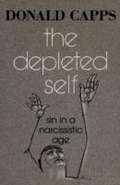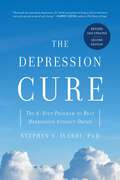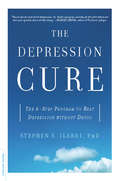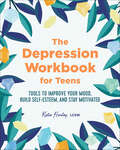- Table View
- List View
The Deeper Wound
by Deepak ChopraThe author of How to Know God provides help for healing deep trauma--whenever it arises--so we may find peace in ourselves and in our world.Terror came from the sky, and afterward the world would never be the same. September, 11, 2001, defined tragedy for a generation. On that day Deepak Chopra found himself driving from city to city, meeting thousands of people who begged for meaning and solace in the face of suffering. In response he has written The Deeper Wound, offering a way of healing as a memorial to the thousands of victims who perished.The opening section, "In the Face of Tragedy," defines suffering as the pain that threatens to make life meaningless. When our deepest needs go unfulfilled, suffering begins. We begin to heal when we go beyond personal anger and fear to a realization of our true self, the self that was never afraid and can never be wounded.The true self contains the light that no darkness can attack. Having described a path of awareness and compassion that leads to the light, the second half of The Deeper Wound takes us there through "A Hundred Days of Healing," daily affirmations, exercises, insights, lessons, and questions--each a step out of pain toward a higher reality. "We can become living memorials to tragedy by restoring the power of life," writes Deepak Chopra. "You are that life, you are that power. Let us see if we can find the spark that will make the spiritual flame spring up."Healing yourself comes in two stages--first releasing the energy of suffering, then replacing it with the soul's energy. It is a gentle and fragile path, very much like holding on to a thread as it leads you from step to step.If you take the time to listen to the voice of silence, you will be astonished at the power you have at your command, however long that power has been overlooked.A portion of the proceeds earned by the author and publisher from the sale of this book will be donated to the Red Cross to aid in humanitarian relief efforts around the world.From the Hardcover edition.
The Deepest Place: Suffering and the Formation of Hope
by Curt Thompson, MDIn the face of personal and global suffering, is it possible to live with hope rather than despair? Join psychiatrist, speaker, and award-winning author Curt Thompson as he shows us how God transforms our grief into a lasting peace that surpasses all understanding.Suffering is a defining reality of life. Yet so many of us are so focused on avoiding discomfort that we've never learned how to actually suffer. But what if we could move from anxiety to durable hope?In The Deepest Place, Thompson invites us to explore how the Apostle Paul's experience of love, secure attachment, and the deeply felt sense of God's abiding presence carried him through the challenges he faced--and how it can help us not just survive, but flourish in the presence of suffering.Combining scripture with his own professional insight, Thompson helps us discover that:Suffering can increase our sense of security rather than our fearsHope is something we form in communityFaith can grow out of anger, cynicism, and doubtPerseverance changes our brain and reshapes our imaginationListening to our bodies helps us find new hope in loss As Thompson reminds us, those who have suffered greatly, including the Apostle Paul, are able to see their stories with a new understanding of God's presence and unfailing love. Let The Deepest Place show you how to do the same.
The Deepest Well: Healing the Long-Term Effects of Childhood Adversity
by Nadine Burke HarrisA pioneering physician reveals how childhood stress leads to lifelong health problems and what we can do to break the cycle. Dr. Nadine Burke Harris was already known as a crusading physician delivering targeted care to vulnerable children. But it was Diego—a boy who had stopped growing after a sexual trauma—who galvanized her to dig deeper into the connections between toxic stress and the lifelong illnesses she was tracking among so many of her patients and their families. A survey of more than 17,000 adult patients’ “adverse childhood experiences,” or ACEs, like divorce, substance abuse, or neglect, had proved that the higher a person’s ACE score the worse their health—and now led Burke Harris to an astonishing breakthrough. Childhood stress changes our neural systems and lasts a lifetime. Through storytelling that delivers both scientific insight and moving stories of personal impact, Burke Harris illuminates her journey of discovery, from research labs nationwide to her own pediatric practice in San Francisco’s Bayview-Hunters Point. For anyone who has faced a difficult childhood, or who cares about the millions of children who do, the innovative and acclaimed health interventions outlined in The Deepest Well will represent vitally important hope for change.
The Defining Decade: Why Your Twenties Matter--And How to Make the Most of Them Now (Playaway Adult Nonfiction Ser.)
by Meg Jay<P>Our "thirty-is-the-new-twenty" culture tells us that the twenty-something years don't matter. Some say they are an extended adolescence. Others call them an emerging adulthood. <P>But thirty is not the new twenty. <P>In this enlightening book, Dr. Meg Jay reveals how many twenty-somethings have been caught in a swirl of hype and misinformation that has trivialized what are actually the most defining years of adulthood. <P>Drawing from more than ten years of work with hundreds of twenty-something clients and students, Dr. Jay weaves the science of the twenty-something years with compelling, behind-closed-doors stories from twenty-somethings themselves. <P>She shares what psychologists, sociologists, neurologists, reproductive specialists, human resources executives, and economists know about the unique power of our twenties and how they change our lives. <P>The result is a provocative and sometimes poignant read that shows us why our twenties do matter. Our twenties are a time when the things we do--and the things we don't do--will have an enormous effect across years and even generations to come.
The Definition Of Us
by Sarah HarrisNORMAL (definition)(adj.) Conforming to a standard; regular, typical or expected(urban) A word inapplicable to human beings(Florence) Round, smooth and bumpy like a cobbled streetFlorence doesn't always see things the way other people do. She feels different. When Florence meets Jasper, Andrew and Wilf she can't imagine they'd have much in common - with at least five mental health conditions between them, they all have very different reasons for being referred to Manor Lane Therapy Centre.It's only when their therapist, Howard, goes missing that they find a common purpose. Worried by his disappearance and wanting answers, the four of them decide to track him down. As they cross the country in a 'borrowed' van, asking each other Ultimate Questions and facing a series of challenges along the way, they start to reveal their true selves - and Florence realises there's more to all of them than just a diagnosis . . . Maybe they're not so different after all? Full of irreverent humour, witty dialogue and characters you can't help but fall in love with, this timely novel is perfect for fans of John Green, Rainbow Rowell and Jennifer Niven.'This is without a doubt one of the best (if not THE best) YA book about mental health that I've read; Sarah Harris takes such a delicate subject, weaves humour and love and friendship, and creates such a beautiful book' Beautiful Bookland'This endearing story does much to enlighten readers of all ages by dispelling myths surrounding mental health in a rollickingly entertaining manner . . . a heart-warming odyssey' Peterborough Telegraph'I can honestly say that this is the best book about mental health that I've read to date. The representation, understanding, acceptance and 'relatability' of mental health portrayed in this book was, in my opinion, flawless. It's juxtaposed with sweetness, humour, romance and friendship and I enjoyed every minute of it' My Endless Shelf'Everything I love about contemporary YA . . . highly recommended' Goodreads reviewer'The characters, the story, the writing - all of it was endearing and wonderful, and now I hold this book so close to my heart' Goodreads reviewer
The Definition of a Profession: The Authority of Metaphor in the History of Intelligence Testing, 1890-1930
by JoAnne BrownIn the early twentieth century, a small group of psychologists built a profession upon the new social technology of intelligence testing. They imagined the human mind as quantifiable, defining their new enterprise through analogies to the better established scientific professions of medicine and engineering. Offering a fresh interpretation of this controversial movement, JoAnne Brown reveals how this group created their professional sphere by semantically linking it to historical systems of cultural authority. She maintains that at the same time psychologists participated in a form of Progressivism, which she defines as a political culture founded on the technical exploitation of human intelligence as a "new" natural resource. This book addresses the early days of the mental testing enterprise, including its introduction into the educational system. Moreover, it examines the processes of social change that construct, and are constructed by, shared and contested cultural vocabularies. Brown argues that language is an integral part of social and political experience, and its forms and uses can be specified historically. The historical and theoretical implications will interest scholars in the fields of history, politics, psychology, sociology of knowledge, history and philosophy of social science, and sociolinguistics.
The Definitive Book of Body Language: The Hidden Meaning Behind People's Gestures and Expressions (Mira Ser.)
by Barbara Pease Allan PeaseAvailable for the first time in the United States, this international bestseller reveals the secrets of nonverbal communication to give you confidence and control in any face-to-face encounter-from making a great first impression and acing a job interview to finding the right partner.It is a scientific fact that people's gestures give away their true intentions. Yet most of us don't know how to read body language-and don't realize how our own physical movements speak to others. Now the world's foremost experts on the subject share their techniques for reading body language signals to achieve success in every area of life.Drawing upon more than thirty years in the field, as well as cutting-edge research from evolutionary biology, psychology, and medical technologies that demonstrate what happens in the brain, the authors examine each component of body language and give you the basic vocabulary to read attitudes and emotions through behavior. Discover:* How palms and handshakes are used to gain control* The most common gestures of liars* How the legs reveal what the mind wants to do* The most common male and female courtship gestures and signals* The secret signals of cigarettes, glasses, and makeup* The magic of smiles-including smiling advice for women* How to use nonverbal cues and signals to communicate more effectively and get the reactions you wantFilled with fascinating insights, humorous observations, and simple strategies that you can apply to any situation, this intriguing book will enrich your communication with and understanding of others-as well as yourself.From the Hardcover edition.
The Definitive Guide to Addiction Interventions: A Collective Strategy
by Louise Stanger Lee WeberWritten for a broad audience of medical and behavioral healthcare professionals, The Definitive Guide to Addiction Interventions: A Collective Strategy introduces clinicians to best practices in addiction interventions and bridges the gap between the theory and practice of successful intervention. Synthesizing decades of fieldwork, Louise Stanger explores the framework for successful invitations to change, what they look like in action, and how to adjust approach by population, and Lee Weber serves as editor. The authors summarize and compare intervention models in use today and explain the use of family mapping and individual portraiture as clinical tools. The text also teaches clinicians to troubleshoot common situations as they help move clients toward positive life decisions. Practical, ready-to-use clinical tools follow the text in downloadable worksheet form.
The Deja Vu Experience (Essays in Cognitive Psychology)
by Alan S. BrownMost of us have been perplexed by a strange sense of familiarity when doing something for the first time. We feel that we have been here before, or done this before, but know for sure that this is impossible. In fact, according to numerous surveys, about two-thirds of us have experienced déjà vu at least once, and most of us have had multiple experiences. There are a number of credible scientific interpretations of déjà vu, and this book summarizes the broad range of published work from philosophy, religion, neurology, sociology, memory, perception, psychopathology, and psychopharmacology. This book also includes discussion of cognitive functioning in retrieval and familiarity, neuronal transmission, and double perception during the déjà vu experience.
The Delicate Art Of Dancing With Porcupines: Learning To Appreciate The Finer Points Of Others
by Bob Phillips Ed StewartThese categories, drawn from the work of research-ers David W. Merrill and Roger H. Reid, can help you understand your own social style and styles of others. Techniques for reducing tension and tips for improving relationships and many more.
The Delivery of Psychological Services in Schools: Concepts, Processes, and Issues (Routledge Library Editions: Psychology of Education)
by Rik Carl D’Amato and Raymond S. DeanOriginally published in 1986, the volume is organized into three parts: Basic Issues, Models and Settings, and Evaluation and Development. The Editors begin with a description of the major conceptual dimensions and the fundamental questions that affect the practice of school psychology. Part 2 focuses on psychological service delivery issues as they are affected by particular models of service delivery and the settings in which a service is provided. Part 3 consists of various evaluation and development issues that influence school psychology. Taken together, the chapters provide a comprehensive view of major service delivery issues within school psychology. In addition, virtually all of the chapters offer suggestions about needed directions for the field and many identify avenues by which these new directions can be accomplished.
The Delusional Person: Bodily Feelings in Psychosis
by Salomon ResnikIn a long and distinguished career Salomon Resnik has established himself as a psychoanalyst of international reputation. The present volume gathers together, for the first time in an English translation, writings essential for a fuller understanding of his important and original ideas.
The Delusions of Certainty
by Siri HustvedtPrizewinning novelist, feminist, and scholar Siri Hustvedt turns her brilliant and critical eye toward the metaphysical issues of neuropsychology in this lauded, standalone volume. Originally published in her collection A Woman Looking at Men Looking at Women, The Delusions of Certainty exposes how the age-old, unresolved mind-body problem has shaped - and often distorted and confused - contemporary thought in neuroscience, psychiatry, genetics, artificial intelligence, and evolutionary psychology.
The Delusions of Certainty
by Siri Hustvedt&“The Delusions of Certainty is a unique book by an extraordinary author. Siri Hustvedt is a notable novelist, art scholar, and a philosopher of science. In this memorable and immensely enjoyable volume, Hustvedt rises above the exhausted debate over the two cultures, to demonstrate not just the possibility but also the advantages of combining the approaches of the arts, humanities, and sciences to illuminate a key aspect of the human condition: the mind-body problem.&” —Antonio Damasio, bestselling author of Descartes&’ Error and Self Comes to Mind &“Siri Hustvedt proves her membership in the highest rank of neuroscientists and philosophers who probe the nature of thought and the workings of consciousness. A novelist and a student of psychoanalysis and neuroscience, Hustvedt can ask questions others cannot ask about imagination, identity, epistemology, gendered power, and mortality. Her authoritative knowledge and her courage to challenge the status quo guide the reader to fresh epiphanies about what counts as human nature. The work is, in the end, a work of freedom.&” —Rita Charon, Columbia University &“The Delusions of Certainty is the best book on the mind-body problem I have ever read. Perhaps only a great novelist and essayist can address what neuroscientists and philosophers fail to question. Siri Hustvedt takes the reader on an inspiring journey into highly relevant and often unanswered questions about what it means to be human.&” —Vittorio Gallese, University of Parma Prizewinning novelist, feminist, and scholar Siri Hustvedt turns her brilliant and critical eye toward the metaphysical issues of neuropsychology in this lauded, standalone volume. Originally published in her &“canonical&” (Publishers Weekly) and &“absorbing&” (Kirkus Reviews) collection A Woman Looking at Men Looking at Women, The Delusions of Certainty exposes how the age-old, unresolved mind-body problem has shaped—and often distorted and confused—contemporary thought in neuroscience, psychiatry, genetics, artificial intelligence, and evolutionary psychology.
The Delusions of Crowds: Why People Go Mad in Groups
by William J. BernsteinThis “disturbing yet fascinating” exploration of mass mania through the ages explains the biological and psychological roots of irrationality (Kirkus Reviews).From time immemorial, contagious narratives have spread through susceptible groups—with enormous, often disastrous, consequences. Inspired by Charles Mackay’s nineteenth-century classic Memoirs of Extraordinary Popular Delusions and the Madness of Crowds, neurologist and author William Bernstein examines mass delusion through the lens of current scientific research in The Delusions of Crowds.Bernstein tells the stories of dramatic religious and financial mania in western society over the last five hundred years—from the Anabaptist Madness of the 1530s to the dangerous End-Times beliefs that pervade today’s polarized America; and from the South Sea Bubble to the Enron scandal and dot com bubbles. Through Bernstein’s supple prose, the participants are as colorful as their “desire to improve one’s well-being in this life or the next.”Bernstein’s chronicles reveal the huge cost and alarming implications of mass mania. He observes that if we can absorb the history and biology of this all-too-human phenomenon, we can recognize it more readily in our own time, and avoid its frequently dire impact.
The Dementia Manifesto: Putting Values-Based Practice to Work (Values-Based Practice)
by Julian C. Hughes Toby WilliamsonThis book represents a new turn in approaching dementia. It is a manifesto which sets out important principles about the nature of dementia both as a disease and as a disability and explores how a values-based, person-centred and rights-based approach can be applied to every aspect of the experience of dementia. Using vignettes, the book covers a variety of issues such as diagnosis, treatment, care, social attitudes, research, public policy and funding. It reflects the considerations of the patient and their carers as well as the perspectives of healthcare professionals, researchers and policy makers. The Dementia Manifesto promotes the concepts of 'values' and disability rights, as well as the growing focus on creating an environment for people to live well with their condition. It will appeal to a range of clinicians, practitioners, academics and students from a variety of specialties.
The Dementias: Early Diagnosis and Evaluation
by Chris Morris Karl Herholz Daniela PeraniThe only guide to focus primarily on current molecular methods of diagnosis and early stage evaluation, this reference presents the latest techniques and technologies for dementia identification and evaluation, including neuropathological strategies, neuropsychological tests, biomarkers, CT, MRI, functional MRI, PET, and SPECT. Offering practical care and examination guidelines, each chapter provides findings that are particularly relevant for the assessment of disorders such as Alzheimer's disease, dementia with Lewy bodies, vascular dementia, and fronto-temporal dementia.
The Demon in the Machine: How Hidden Webs of Information Are Solving the Mystery of Life
by Paul DaviesWhat is life? For generations, scientists have struggled to make sense of this fundamental question, for life really does look like magic: even a humble bacterium accomplishes things so dazzling that no human engineer can match it. Huge advances in molecular biology over the past few decades have served only to deepen the mystery. In this penetrating and wide-ranging book, world-renowned physicist and science communicator Paul Davies searches for answers in a field so new and fast-moving that it lacks a name; it is a domain where biology, computing, logic, chemistry, quantum physics, and nanotechnology intersect. At the heart of these diverse fields, Davies explains, is the concept of information: a quantity which has the power to unify biology with physics, transform technology and medicine, and force us to fundamentally reconsider what it means to be alive—even illuminating the age-old question of whether we are alone in the universe. From life’s murky origins to the microscopic engines that run the cells of our bodies, The Demon in the Machine journeys across an astounding landscape of cutting-edge science. Weaving together cancer and consciousness, two-headed worms and bird navigation, Davies reveals how biological organisms garner and process information to conjure order out of chaos, opening a window onto the secret of life itself.
The Demons of William James: Religious Pragmatism Explores Unusual Mental States
by Tadd RuetenikThis book is a psychological exploration of unusual minds, a religious exploration of demonological myth, and a philosophical exploration of the reaches of pragmatism. It uses topics such as hypnotism, mediumship, and mass possession to argue for a comprehensive understanding of the demonic that acknowledges not only the creativity which it encourages, but also the danger it can bring. Professor Ruetenik uses James’ religious pragmatism to evaluate the relevance of psychical research, and to explain common beliefs regarding demons, spirits, and other controlling personalities. The conclusion of this interdisciplinary research is as alarming as it is fascinating: When exploring the demons of William James, we discover that ordinary personality cannot be clearly separated from what we consider the demonic.
The Denial of Death
by Ernest BeckerWinner of the Pulitzer Prize, The Denial of Death explores how people and cultures around the world have reacted to the concept of death from celebrated cultural anthropologist Ernest Becker.Winner of the Pulitzer Prize in 1974 and the culmination of a life&’s work, The Denial of Death is Ernest Becker&’s brilliant and impassioned answer to the &“why&” of human existence. In bold contrast to the predominant Freudian school of thought, Becker tackles the problem of the vital lie—man&’s refusal to acknowledge his own mortality. In doing so, he sheds new light on the nature of humanity and issues a call to life and its living that still resonates decades after its writing.
The Dependents
by Katharine DionOne of TIME magazine's best summer reads, a "wise" (Entertainment Weekly) and "resplendent" (O, The Oprah Magazine) debut that follows a new widower confronting the truth about his long marriageOne of the best books of the summer: TIME, Entertainment Weekly, O: The Oprah Magazine, Real Simple, Brit + Co."A fine debut, full of intelligent writing . . . This book pleases on many levels." --Jeffrey Eugenides"The Dependents is a big book, one that grapples with important questions through generations...Dion's intelligence and ambition truly shine through sentence after sentence." --Kate Walbert, National Book Award finalist and author of A Short History of WomenAfter the sudden death of his wife, Maida, Gene is haunted by the fear that their marriage was not all it appeared to be. Alongside Ed and Gayle Donnelly, friends since college days, he tries to resurrect happy memories of the times the two couples shared, raising their children in a small New Hampshire town and vacationing together at a lake house every summer. Meanwhile, his daughter, Dary, challenges not only his happy version of the past but also his view of Maida. As a long-standing rift between them deepens, Gene starts to understand how unknown his daughter is to him--and how enigmatic his wife was as well. And a lingering suspicion seizes his mind that could upend everything he thought he knew. Katharine Dion's assured debut moves seamlessly between Gene's present-day journey and the long history of a marriage and friendship. Rich and wonderfully alive, The Dependents is the most moving kind of drama, an intimate glance into the expanse of family life and the way we must all eventually bridge the chasm between what we want to believe and what we know to be true.
The Depleted Self: Sin in a Narcissistic Age
by Donald CappsAlthough narcissism may appear dormant in the 1990s, clinical research on narcissism shows that behind a grandiose, exhibitionistic side lies a shame-ridden half of self-loathing, unworthiness, and depression. Capps says that traditional theologies of guilt are unable to address those gripped by shame and makes a case for a different pastoral approach in counseling and ministry.
The Depression Cure: The 6-Step Program to Beat Depression without Drugs
by Stephen S. IlardiThe go‑to, revelatory guide based on Dr. Stephen Ilardi's proven Therapeutic Lifestyle Change (TLC) program—a practical plan for natural ways to treat depression without medication. Now updated with new research.The Depression Cure will change the way we think about and manage depression. Dr. Stephen Ilardi sheds light on our current predicament and reminds us that our bodies were never designed for the sleep‑deprived, poorly nourished, frenzied pace of twenty‑first century life. Inspired by the extraordinary resilience of aboriginal groups like the Kaluli of Papua New Guinea, Dr. Ilardi prescribes an easy‑to‑follow, clinically proven program that harks back to what our bodies were originally made for and what they continue to need with these six components: · Nutrition · Fighting Rumination · Antidepressant Exercise · Light Box Therapy · Getting Connected · Healthy Sleep Habits Since the first edition of The Depression Cure was published, depression rates have continued to skyrocket, especially after the upheaval of the COVID‑19 pandemic. The Depression Cure's holistic approach has shown to produce positive results at a hope-inspiring rate, even for those who were not improved by traditional medication.
The Depression Cure: The 6-step Program To Beat Depression Without Drugs
by Steve IlardiMost Americans work long hours, eat on the fly, and lead increasingly sedentary, isolated lives. Alongside this lifestyle, depression rates have skyrocketed: approximately 1 in 4 Americans will suffer from major depression at some point in their lives. Where have we gone wrong? Dr. Stephen Ilardi sheds light on our current predicament and reminds us: our bodies were never designed for the sleep-deprived, poorly nourished, frenzied pace of twenty-first century life. In fact, our genes have changed very little since the days of our hunter-gatherer ancestors and are still building, in effect, Stone Age bodies. Herein lies the key to breaking the cycle of depression. Inspired by the extraordinary resilience of aboriginal groups like the Kaluli of Papua New Guinea (who rarely suffer from depression), Dr. Ilardi prescribes an easy-to-follow, clinically proven program that harks back to what our bodies were originally made for-and need. Here you can find the road back to lasting health by integrating the following 6 elements into your life: an omega-3 rich diet; exercise; plenty of natural sunlight; ample sleep; social connections; and participation in meaningful tasks that leave little time for negative thoughts--all things that our ancestors had in abundance. Already, The Depression Cure program has delivered dramatic results, helping even those who have failed to respond to traditional medications. Interweaving the stories of many who have fought-and won-the battle against this debilitating illness, this groundbreaking book can illuminate the path to lifting the fog once and for all for you or a loved one.
The Depression Workbook for Teens: Tools to Improve Your Mood, Build Self-Esteem, and Stay Motivated
by Katie HurleyFind relief from depression symptoms with advanced tools for teens ages 12 to 17This depression workbook draws on the most effective and up-to-date techniques, like cognitive behavioral therapy and mindfulness, to deliver simple exercises that help teens learn how to conquer depression.Learn how to identify the differences between normal stress and depression, and find easy exercises designed to help you develop the skills you need to manage your emotional well-being and bring happiness back into your life.The Depression Workbook for Teens includes:Advice for teens—Tackle your depression head-on using strategies written with your unique needs and time constraints in mind.Useful tools—With quizzes, journaling prompts, conversation starters, and more, you'll discover simple skill-building exercises that improve your mood and build your self-esteem.Practical problem solving—Find ways to work through the challenges you're facing, like fighting with your parents, getting up in the morning, struggling with homework, and more.The Depression Workbook for Teens gives you the helping hand you need to get through this difficult time.
